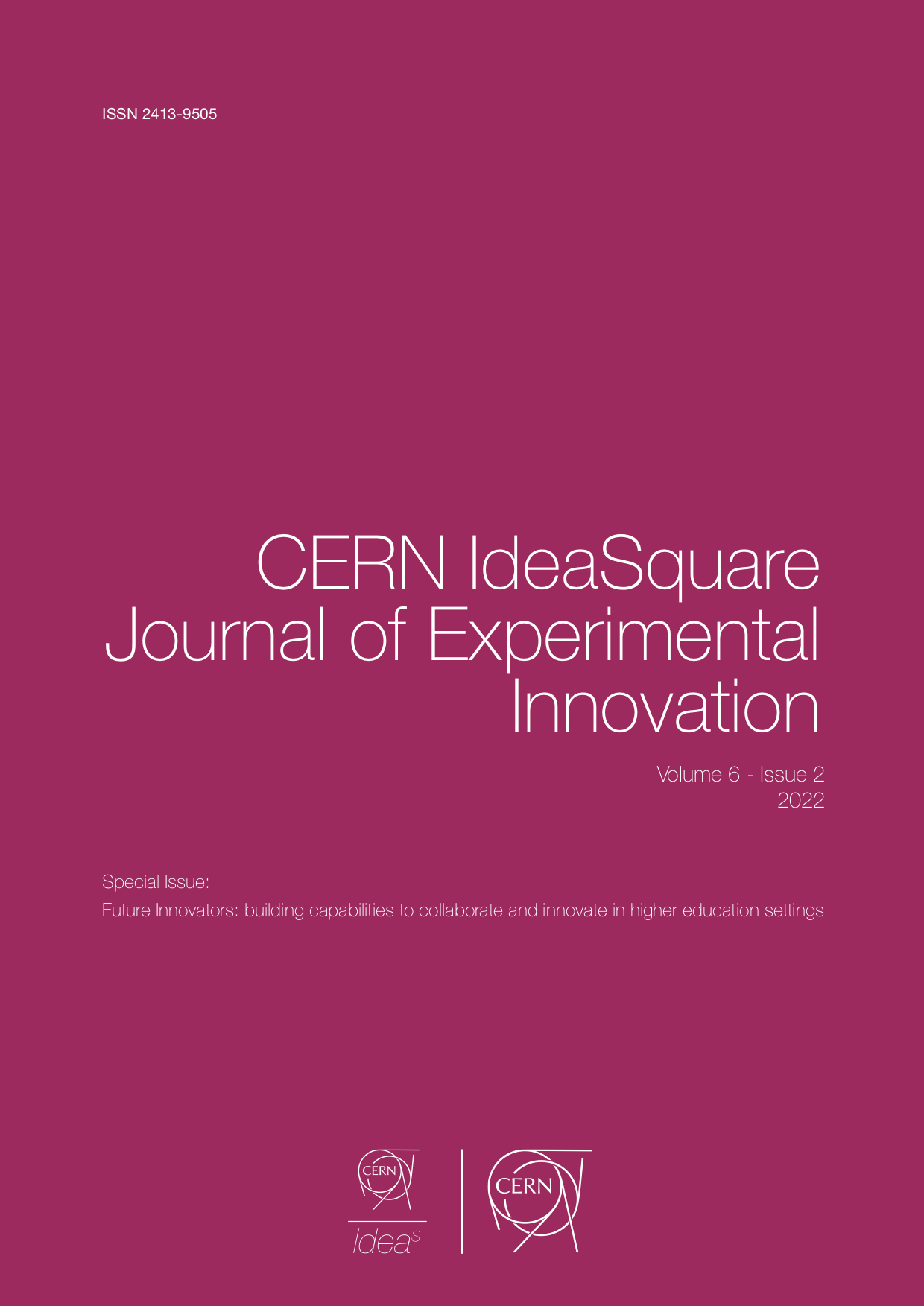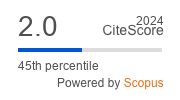Understanding engineering students' perceptions of their curiosity, diligence, and perseverance and assessing its impact on their creativity
DOI:
https://doi.org/10.23726/cij.2022.1398Keywords:
Creativity, Engineering, Curiosity, Diligence, Perseverance, Education, DesignAbstract
Creativity has been among the most in-demand skills for many years. Previous studies have shown that being curious, hard-working, and persevering can significantly impact one's performance. This article is an exploratory study to understand engineering students' self-perception towards their own 1) Curiosity, 2) Diligence, and 3) Perseverance and how it affects their creativity. The research uses a well-curated study based on a survey, rubrics and statistics. The study found that curiosity has the highest potential to support creativity. However, it also has a rather intriguing relationship with diligence and perseverance. Awareness of the dynamic correlations between these three aspects can help educators design their pedagogical practices to support students to be more creative problem solvers.
References
Abedini, Y., 2020, Students' creativity in virtual vs. Classroom courses on the basis of their personality traits: A prediction study, Electronic Journal of E-Learning, 18(6): 525-536.
Agarwal, U. A., 2014, Examining the impact of social exchange relationships on innovative work behaviour: Role of work engagement, Team Performance Management 20(3/4): 102-120. https://doi.org/10.1108/TPM-01-2013-0004
Alberti, E. T., and Witryol S. L., 1994, The relationship between curiosity and cognitive ability in third-and fifth-grade children, The Journal of Genetic Psychology 155(2): 129-145.
Amabile, T. M., et al., 2018, Creativity in context: Update to the social psychology of creativity, Routledge, Milton Park, UK.
Arthur, C. G., 2000, The relationships between student diligence, student support systems, other related variables and student academic outcomes in high schools in Grenada, Dissertations. 199. https://digitalcommons.andrews.edu/dissertations/199
Benjamins, R., et al., 1996, Assumptions of problem-solving methods and their role in knowledge engineering. ECAI 96. 12th European Conference on Artificial Intelligence. John Wiley & Sons, Ltd, Hoboken, NJ, USA.
Cattell, R. B., 1946a, Description and measurement of personality. World Book Company, Oxford, England.
Celik, P., et al., 2016, Work-related curiosity positively predicts worker innovation, Journal of Management Development 35(9): 1184-1194. https://doi.org/10.1108/JMD-01-2016-0013
Chen, B.-B., 2016, Conscientiousness and everyday creativity among Chinese undergraduate students, Personality and Individual Differences 102: 56-59.
Christensen, R., and Knezek G., 2014, Comparative measures of grit, tenacity and perseverance, International Journal of Learning, Teaching and Educational Research; 8(1):16-30.
Cohen, J., 1960, A coefficient of agreement for nominal scales, Educational and psychological measurement 20(1): 37-46.
Corgnet, B., et al., 2016, Creativity and cognitive skills among millennials: Thinking too much and creating too little, Frontiers in Psychology 7: 1626.
Cronbach, L. J., 1951, Coefficient alpha and the internal structure of tests, Psychometrika 16(3): 297-334.
Deo, S., et al., 2021, Idea Generation Mechanisms: Comparing the Influence of Classification, Combination, Building on Others, and Stimulation Mechanisms on Ideation Effectiveness, Journal of Mechanical Design 143(12).
Deo, S., et al., 2020, Creativity and engineering education: Assessing the impact of a multidisciplinary project course on engineering students' creativity, International Design Engineering Technical Conferences and Computers and Information in Engineering Conference, American Society of Mechanical Engineers. https://doi.org/10.1115/DETC2020-22250
Duckworth, A. L., et al., 2007, Grit: perseverance and passion for long-term goals, Journal of personality and social psychology 92(6): 1087.
Duckworth, A. L., and Quinn P. D., 2009, Development and validation of the Short Grit Scale (GRIT–S), Journal of personality assessment 91(2): 166-174.
Eisenberger, R. and Shanock L., 2003, Rewards, intrinsic motivation, and creativity: A case study of conceptual and methodological isolation, Creativity Research Journal 15(2-3): 121-130.
Eisenberger, R., et al., 1990, Perceived organizational support and employee diligence, commitment, and innovation, Journal of Applied Psychology 75(1): 51.
Fadljević, L., Maitz, K., Kowald, D., Pammer-Schindler, V. and Gasteiger-Klicpera, B., 2020, Slow is good: the effect of diligence on student performance in the case of an adaptive learning system for health literacy. In: Proceedings of the Tenth International Conference on Learning Analytics & Knowledge, pp. 112-117.
Fiske, D. W., 1949, Consistency of the factorial structures of personality ratings from different sources, Journal of Abnormal and Social Psychology, 44: 329-344.
Galla, B.M., Esposito, M.V. and Fiore, H.M., 2020, Mindfulness predicts academic diligence in the face of boredom, Learning and Individual Differences 81: 101864.
Galla, B. M., et al., 2014, The Academic Diligence Task (ADT): Assessing individual differences in effort on tedious but important schoolwork, Contemporary Educational Psychology 39(4): 314-325.
Galton, F., 1870, Hereditary genius: An inquiry into its laws and consequences, D. Appleton.
Goldberg, L. R., 1992, The development of markers for the Big-Five factor structure, Psychological Assessment 4(1): 26.
Grow, K., 2017, Four Ways Diligence Can Make Your Work Easier and More Rewarding. https://www.forbes.com/sites/forbesagencycouncil/2017/10/30/four-ways-diligence-can-make-your-work-easier-and-more-rewarding/?sh=125b1e952d4e
Guilford, J. P., 1967, Creativity: Yesterday, today, and tomorrow, The Journal of Creative Behavior 1(1): 3-14.
Howe, M. J., 2001, Genius explained, Cambridge University Press, Cambridge, UK.
Huang, X., 2021, Striving for better teaching and student creativity development: Linking informal workplace learning and teaching for creativity, Thinking Skills and Creativity 41: 100889.
Jankowska, D. M., et al., 2019, Exploring links between creative abilities, creative personality and subclinical autistic traits, Personality and Individual Differences 142: 226-231.
John, O. P. and Srivastava S., 1999, The Big-Five trait taxonomy: History, measurement, and theoretical perspectives.In: L. Pervin and O.P. John (Eds.), Handbook of personality: Theory and research (2nd ed.). Guilford, New York, NY, USA.
Kashdan, T. B., et al., 2020, The Five-Dimensional Curiosity Scale Revised (5DCR): Briefer subscales while separating overt and covert social curiosity, Personality and Individual Differences 157: 109836.
Kashdan, T. B., et al., 2018, The five-dimensional curiosity scale: Capturing the bandwidth of curiosity and identifying four unique subgroups of curious people, Journal of Research in Personality 73: 130-149.
Kershaw, T. C., et al., 2019, A decision tree-based methodology for evaluating creativity in engineering design, Frontiers in Psychology 10: 32.
Kirjavainen, S. and Hölttä-Otto K., 2021, Deconstruction of idea generation methods into a framework of creativity mechanisms, Journal of Mechanical Design 143(3).
Lakhal, S. and Khechine H., 2017, Relating personality (Big Five) to the core constructs of the Unified Theory of Acceptance and Use of Technology, Journal of Computers in Education 4(3): 251-282.
Lee, J.W., Daly, S.R., Huang-Saad, A.Y., Seifert, C.M. and Lutz, J., 2018, Using design strategies from microfluidic device patents to support idea generation, Microfluidics and Nanofluidics, 22(7): 1-22.
Mamaril, N.A., Usher, E.L., Li, C.R., Economy, D.R. and Kennedy, M.S., 2016, Measuring undergraduate students' engineering self‐efficacy: A validation study, Journal of Engineering Education, 105(2): 366-395.
Mayer, R. E., 2006, The role of domain knowledge in creative problem solving, Creativity and reason in cognitive development: 145-158.
McCrae, R. R. and John O. P., 1992, An introduction to the five‐factor model and its applications, Journal of Personality 60(2): 175-215.
McGraw, K. O., and Fiala J., 1982, Undermining the Zeigarnik effect: Another hidden cost of reward, Journal of Personality 50(1): 58-66.
Mrazek, A. J., et al., 2018, Expanding minds: Growth mindsets of self-regulation and the influences on effort and perseverance, Journal of Experimental Social Psychology 79: 164-180.
Mussel, P., 2010, Epistemic curiosity and related constructs: Lacking evidence of discriminant validity, Personality and Individual Differences 49(5): 506-510.
Norman, W.T., 1963, Toward an adequate taxonomy of personality attributes: Replicated factor structure in peer nomination personality ratings, The Journal of Abnormal and Social Psychology, 66(6): 574.
Novikova, I.A., Berisha, N.S., Novikov, A.L. and Shlyakhta, D.A., 2020, Creativity and personality traits as foreign language acquisition predictors in university linguistics students, Behavioral Sciences, 10(1): 35.
Pate, D. L., 2020, The skills companies need most in 2020—and how to learn them. Linkedin The learning blog.
Prabhu, V., et al., 2008, Creativity and certain personality traits: Understanding the mediating effect of intrinsic motivation, Creativity Research Journal 20(1): 53-66.
Reio Jr, T. G. and Wiswell A., 2000, Field investigation of the relationship among adult curiosity, workplace learning, and job performance, Human Resource Development Quarterly 11(1): 5-30.
Scherer, R., and Gustafsson J.-E., 2015, The relations among openness, perseverance, and performance in creative problem solving: A substantive-methodological approach, Thinking Skills and Creativity 18: 4-17.
Schiefele, U., et al., 1992, Interest as a predictor of academic achievement: A meta-analysis of research. In: The role of interest in Learning and Development. Psychology Press.
Schutte, N. S. and Malouff, J. M. 2020, A meta‐analysis of the relationship between curiosity and creativity, The Journal of Creative Behavior 54(4): 940-947.
Shah, J. J., et al., 2003, Metrics for measuring ideation effectiveness, Design Studies 24(2): 111-134.
Shechtman, N., et al., 2013, Promoting grit, tenacity, and perseverance: Critical factors for success in the 21st century, Washington, DC: US Department of Education, Department of Educational Technology 1: 1-107.
Som, M. H. M., and Suradi N. R. M., 2019, The effects of personality traits on innovative behaviour: A preliminary study amongst engineering students, AIP Conference Proceedings, AIP Publishing LLC.
Sternberg, R. J. and Lubart T. I., 1999, The concept of creativity: Prospects and paradigms, Handbook of Creativity 1(3-15).
Tavakol, M. and Dennick R., 2011, Making sense of Cronbach's alpha, International Journal of Medical Education 2: 53.
Tiryaki, A. and Adigüzel, S., 2021, The Effect of STEM-Based Robotic Applications on the Creativity and Attitude of Students, Journal of Science Learning, 4(3):288-297.
Toh, C.A. and Miller, S.R., 2016, Creativity in design teams: the influence of personality traits and risk attitudes on creative concept selection, Research in Engineering Design, 27(1): 73-89.
Torrance, E. P., 1970, Encouraging creativity in the classroom, WCB/McGraw-Hill.
Tupes, E. C., & Christal, R. C., 1961, Recurrent personality factors based on trait ratings, Technical Report, USAF, Lackland Air Force Base, TX.
Usher, E. L., Li, C. R., Butz, A. R., & Rojas, J. P., 2019, Perseverant grit and self-efficacy: Are both essential for children's academic success? Journal of Educational Psychology, 111(5): 877–902.
Utriainen, T. and Valtonen L., 2022, Experiencing emotions in design thinking: How positive and negative affects play their part in the innovation process, CERN IdeaSquare Journal of Experimental Innovation 6(1), 2–6. https://doi.org/10.23726/cij.2022.1322
Valentine, A., Belski, I. and Hamilton, M., 2022, Influence of using a pen-and-paper or computer-based approach on engineering students' self-efficacy during idea generation, Australasian Journal of Engineering Education, 1-10.
Valentine, J.C., DuBois, D.L. and Cooper, H., 2004, The relation between self-beliefs and academic achievement: A meta-analytic review, Educational Psychologist, 39(2): 111-133.
Vincent-Lancrin, S., et al., 2019, Fostering Students' Creativity and Critical Thinking: What It Means in School. Educational Research and Innovation, ERIC. https://doi.org/10.1787/62212c37-en
Walsh, C., et al., 2021, The driving mindsets of innovation: Curiosity, creativity and clarity, Journal of Business Strategy 43(2): 71-78. https://doi.org/10.1108/JBS-08-2020-0176
Whiting, K. (2020). These are the top 10 job skills of tomorrow–and how long it takes to learn them. World Economic Forum. https://www.weforum.org/agenda/2020/10/top-10-work-skills-of-tomorrow-how-long-it-takes-to-learn-them/
Wu, T.T. and Wu, Y.T., 2020, Applying project-based learning and SCAMPER teaching strategies in engineering education to explore the influence of creativity on cognition, personal motivation, and personality traits, Thinking Skills and Creativity, 35: 100631.
Yesil, S. and Sozbilir F., 2013, An empirical investigation into the impact of personality on individual innovation behaviour in the workplace, Procedia-Social and Behavioral Sciences 81: 540-551.
Downloads
Published
How to Cite
Issue
Section
Categories
License
Copyright (c) 2022 Saurabh Deo, Abhijeet Malge

This work is licensed under a Creative Commons Attribution 4.0 International License.
Authors who publish with this journal agree to the following terms:
- Authors retain copyright and grant the journal right of first publication with the work simultaneously licensed under a Creative Commons Attribution License that allows others to share the work with an acknowledgement of the work's authorship and initial publication in this journal.
- Authors are able to enter into separate, additional contractual arrangements for the non-exclusive distribution of the journal's published version of the work (e.g., post it to an institutional repository or publish it in a book), with an acknowledgement of its initial publication in this journal.
- Authors are permitted and encouraged to post their work online (e.g., in institutional repositories or on their website) prior to and during the submission process, as it can lead to productive exchanges, as well as earlier and greater citation of published work (See The Effect of Open Access).


